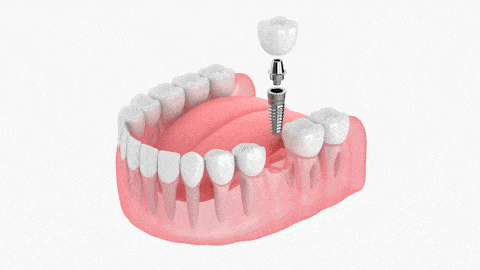Conventional Dental Implants (1)
Many of my patients ask me about implants to replace missing teeth and they want to know what options are available. The answer is, of course, “that depends.” There are 2 basic types of implants commonly referred to as conventional implants and mini implants. In this article, we will address the conventional implant.
 Conventional implants are by current terminology any implant equal to or greater than 3.0 mm in diameter, while mini implants are less than 3.0 mm in diameter. The two implant types have distinct differences aside from how wide they are.
Conventional implants are by current terminology any implant equal to or greater than 3.0 mm in diameter, while mini implants are less than 3.0 mm in diameter. The two implant types have distinct differences aside from how wide they are.
A conventional implant is made up of several different components. We have the implant body, which is the part that is embedded in the jaw. The implant abutment, which is the peg that sticks up through the gum, and the implant screw, which secures the implant abutment to the implant body (see video). Therefore, there are 3 components in a conventional implant.
The implant body is placed into the jaw via a pre-drilled hole that is the exact depth of the implant body being used. The final hole diameter is sequentially arrived at via a series of increasing diameter drills. Once the proper hole has been drilled, the implant body is screwed into it and allowed to heal for 4-6 months.
After 4-6 months, the implant is presumed to be “osseointegrated” or one with the bone. It is at this time that the abutment can be screwed on to the implant body and impressions can be made for the prosthesis (crown) that will fit on to the abutment.
To recap, a conventional crown is equal to or greater than 3.0 mm in diameter. It is comprised of 3 components, fits into full length pre-drilled holes and takes 4-6 months to heal in most cases. In my next blog, I will address how these characteristics effect their use in treatment.
Conventional Dental Implants (2)
In my first blog on conventional implants, we discussed components, placement, and healing time. In this article, I will attempt to show how these characteristics pertain to the selection process or treatment plan.
As a rule of thumb, the bigger the implant the better. Though this does not always hold true, we still like to have the surface area of the implant roughly equal to the root surface area of the tooth being replaced. This is particularly important when BONE DENSITY is less than ideal. Big missing tooth, big implant.
Another popular application for conventional implants is for supporting round house bridge complete dentures. You can visit our round house bridge page to learn more.
By far and away, my most frequent use of conventional implants is when the quality and/or quantity of existing bone is not adequate for the small diameter implants. In order for an implant to integrate into the jaw, it needs to be stable, that is to say, it cannot be moving. In soft bone, a conventional implant can be placed under the gum and allowed to heal without any forces (chewing, etc,) interfering with integration. This principal also applies when the bone height is minimum.
The downside with conventional implants are increased costs, 4-6 months healing period, multiple parts, occasional loosening of the screws that hold them in place, and more complicated surgical placement.
Conventional implants make up the majority of the implants being placed at this time. They are strong, reliable, and have a long track record. They are an integral component in my arsenal.
